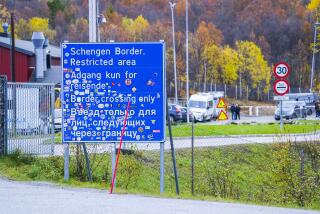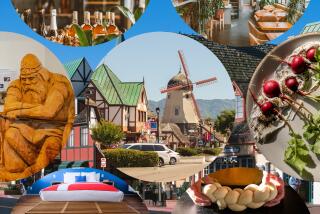In Danish-Swedish Region, Bridge Builds Hopes of Greater Prosperity
- Share via
COPENHAGEN
It’s been 7,000 years since receding glaciers cleaved Denmark from the Scandinavian Peninsula, but the region united by similar languages, culture and economic values is about to get physical again.
A huge suspension-bridge-and-tunnel complex that has been almost a decade in the making opens July 1 to rail and vehicle traffic, linking the peninsula with Western Europe for the first time since the ice melted.
But more than shortening the travel and transport time between two of Europe’s most prosperous countries, the 10-mile, $2-billion span reconnecting Denmark and Sweden is expected to unify a region of 3.5 million residents with common labor and housing markets and one of the Continent’s most vibrant economies.
Few may have heard of the Oeresund region, named for the narrow body of water separating Sweden and Denmark. But those behind the bridge project predict it will become a household word as it brings to life the European Union’s most cherished ideals of eliminating national barriers, fostering economic growth and strengthening cross-cultural ties.
“There is a firm belief among economists and investors that growth in this region will be higher than for Denmark and Sweden in general,” says Jacob Vestergaard, head of the newly formed Oeresund Identity Network seeking to attract investment to the area. “There is more population concentration, investment is up and hopefully foreign investment will also take off.”
Copenhagen, the Danish capital, and Sweden’s third-largest city, Malmo, will be only about a 20-minute journey apart once the bridge is in operation. That will cut the former ferry commute by nearly an hour, and removes a psychological impediment to spontaneous shopping and tourism that the developers predict will grow dramatically.
“We expect the number of commuters to grow from the current 2,000 per day to 10,000 within the next couple of years, and more optimistic people think this will happen overnight,” says Jarn Schauby, chief analyst with Oeresund Consortium, which conceived, built and will manage the span. “This area is an international hub now, and the first to benefit will be international trucking. Drivers can now make more efficient use of their time.”
Indeed, one glance at a map of Europe confirms that Denmark stands in the center of the Continent’s land and sea channels. Its ports, warehouses and loading docks can provide freight handling for ships coming from the North and Baltic seas as well as road transport between the affluent Nordic countries and the economic powerhouses such as Germany, Britain, the Benelux countries and France.
Copenhagen’s international airport at Kastrup--already Europe’s sixth-busiest air hub and the workplace for 20,000--abuts one bridge terminus, allowing easy integration of air, land and sea shipping. Regional planners expect Kastrup’s annual traffic to increase from last year’s 17 million passengers to 25 million within five years because the airspace in northern Europe is less saturated than that around the Continent’s two biggest airports, Frankfurt/Main in Germany and Heathrow near London.
“With the fall of the Iron Curtain, we are no longer on the periphery of Europe,” says Lars Bernhard Joergensen, president of the convention and visitors’ bureau for greater Copenhagen. “Strategically, a whole new situation has followed the political and military stabilization. From the point of view of the business climate, this provides huge stimulation for this part of the world.”
The region’s core industries are biotechnology, pharmaceuticals and information technology, which should continue to generate new jobs and investments in the combined economy, Vestergaard adds.
Partly in anticipation of the economic and social synergies afforded by the bridge, more than 1,000 information technology start-ups have been registered here in the last five years, Joergensen says.
But other manufacturers are also beginning to move here as well, to take advantage of the integrated networks for importing parts and labor and distributing finished products by air, sea, road or rail.
German-U.S. auto giant DaimlerChrysler has already moved its regional headquarters from Stockholm to Malmo, and Coca-Cola Co. and other major companies also are pondering the same shift.
Retail growth is expected to keep pace with the rise in daily traffic across the bridge, predicted to grow 2% a year for the next two decades. At the same time, Vestergaard points out that the span is also likely to increase price competition as shoppers will have a broader range of retailers to choose from.
The soon-to-be-unified retail market has already attracted a number of upscale boutiques such as Kenzo and Armani, which opened Copenhagen branches only recently.
After decades of static tourism, the region is anticipating a boom once the bridge is open. A new 350-room Hilton hotel opens in less than a year at Kastrup and a 400-room Marriott is nearing completion on the Copenhagen waterfront, just across from the city’s new art museum, dubbed the Black Diamond for its polished granite facade.
“The weakness of Copenhagen from the international perspective has always been its lack of critical mass, with a market of only 1.7 million” in and around the city, Joergensen says. “If you don’t have the critical mass, you don’t get the development. Now we will have 3.5 million people within an hour’s drive, which means a lot more buying power.”
The bridge and the boost it promises for the local economies will probably create as many as 3,000 new jobs on the Danish side within the first two years, although most will be workers lured from southern Sweden by the higher wages offered by Danish industries, says Morten Kyhn, chief analyst for Danske Bank.
Kyhn expects it will take as long as five years for job growth to be achieved on the Swedish side because of the complex taxation and labor laws that will need revision.
With the opening of the Baltic Sea area after the fall of communism, Copenhagen has become one of the world’s most frequented destinations for the cruise ship industry as so many ports can be visited in a short time.
“We are developing a very important regional form of cooperation in transportation, environment, universities--the whole range of social concerns,” says Danish Foreign Minister Niels Helveg Petersen, whose office looks out toward Sweden across Copenhagen’s main shipping harbor.
Noting that Denmark is the only Nordic country belonging to both the European Union and the North Atlantic Treaty Organization, Petersen says his country has a special obligation to develop regional projects benefiting the newly democratized nations and zones along the Baltic: Poland, Russia’s St. Petersburg area and the former Soviet republics of Lithuania, Latvia and Estonia.
With its 1.2 million residents, Copenhagen is much more densely populated and urban than the Malmo region, where land and housing are more affordable and the city’s 250,000 residents get more space for their kronor. For that reason, developers expect thousands of Danes to move from crowded and expensive Copenhagen to southern Sweden during the next decade and take advantage of the bridge to commute.
“Some Swedes are annoyed by this role they are acquiring as a suburb, but they will be connected to a major metropolitan area and development will be enhanced on the Swedish side as well,” Schauby says.
The bridge, which was completed in August except for road surfacing and signals, makes the combined Copenhagen-Malmo region the eighth-largest metropolitan area in Europe and Scandinavia’s largest labor market. Oeresund also hosts 15 universities and colleges with 130,000 students.
Swedish and Danish lawmakers are working to harmonize tax and investment laws to remove what discrepancies exist. Both governments have committed themselves to fostering a fully integrated and borderless Oeresund region.
When the bridge opens to traffic at 11 p.m. July 1, the consortium expects nearly 12,000 vehicle crossings a day, says spokesman Nils Francke.
Traffic is carried in what builders call a “sandwich” construction, with four vehicle lanes--two in each direction--on the top surface of the bridge and trains traveling underneath on a lower level. In the 2.5-mile submerged portion of the span on the Danish side, the segregated vehicle and rail tunnels are built side by side .
Most cargo from the more industrialized areas of southern Sweden and Norway will continue to make its way to Eastern Europe on ferries serving Baltic Sea ports, Schauby says, noting that the main beneficiaries of the bridge are those with business in Western Europe.
The $2-billion project, co-financed by loans backed by the two national governments and the European Union, will be paid off by tolls set at the same fares as the ferry services the bridge will replace, with frequent users gaining significant discounts. The toll for a one-time passenger car’s crossing will be about $30. The figure drops to $11 per crossing, though, for regular users.
Inauguration of the Oeresund bridge and tunnel will come only two years after the opening of the Great Belt Bridge linking Denmark’s two most populous islands.
More to Read
Sign up for Essential California
The most important California stories and recommendations in your inbox every morning.
You may occasionally receive promotional content from the Los Angeles Times.














